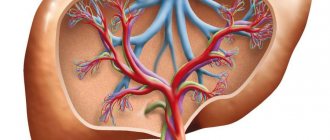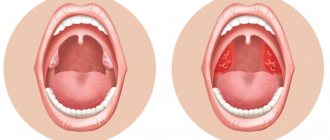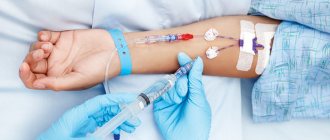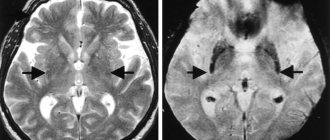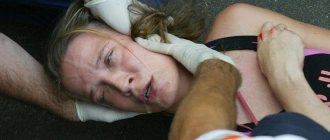Causes of Creutzfeldt-Jakob disease
The main cause of this disorder is considered to be eating meat from animals suffering from spongy encephalopathy. In addition, there have been cases of infection of patients in medical institutions through poorly sterilized surgical instruments or through transplanted tissue. Episodes of infection of people undergoing hormone therapy aimed at eliminating growth hormone deficiency, when treatment was carried out using tissue extracts containing this hormone, have been described.
In addition to cases of infection from the outside, there is a hereditary factor that causes Creutzfeldt-Jakob disease. This form of the disease is associated with a mutation in the PRNP gene. This disorder causes the appearance of pathological prions in the body. The hereditary disease is observed in 10-15% of families in which any form of this disorder has ever been diagnosed.
Causes of pathology
CJD is found everywhere, but at the same time, the mechanism of infection is not fully understood.
A couple of cases of infection have been described during penetrating keratoplasty (corneal transplantation) and some other transplantations. Cases of the use of contaminated instruments during brain operations have been recorded.
Infection occurred when growth hormone was taken from the pituitary gland of a corpse (at the moment there is a synthetic analogue of it). As already mentioned, there is a route of infection through the meat of sheep and cows.
Classification of Creutzfeldt-Jakob disease
According to the classification, Creutzfeldt-Jakob disease is divided into 4 types:
- Classical. In this form of the disease, prions attack the brain for no apparent reason. This type of mad cow disease is most often observed in people over 50 years of age, and is extremely rare - in 1-2 cases per million. The infection manifests itself as memory loss, sudden mood changes, and decreased interest in life. Subsequently, the patient loses the ability to care for himself, loses vision and practically stops speaking. In the final stages, the patient experiences severe hallucinations.
- Hereditary. The course of the stages of the disease is similar to the classical type, but the cause of the disease is the genetic inheritance of prions.
- Iatrogenic. The patient becomes infected with this type of disease during surgery through medications, poorly sterilized instruments, and membranes used to close wounds. In the 21st century, the likelihood of contracting Creutzfeldt-Jakob disease during surgery is almost zero.
- New option. A form of the disease in which infection occurs through meat foods containing infected tissue. More than a hundred cases of the disease have been reported since 1995. The disease especially often affects young people, with an average age of 20 years. The initial stage of the disease is marked by depression, loss of interest in hobbies and work, isolation and a desire for loneliness. Next comes a lack of coordination of movements, an inability to eat and clean up on one’s own. Unlike the classical type, with this variant of the disease dementia occurs last, and the patient is aware of everything that is happening to him.
Symptoms of Creutzfeldt-Jakob disease
The early period of the disease is characterized by a symptom such as a change in personality, in which a person becomes restless. This stage is also characterized by depression, insomnia, forgetfulness and a significant deterioration in intellectual abilities. Gradually, the patient loses his vision, which contributes to the loss of the ability to adequately care for himself. This is followed by difficulty swallowing food and water, and the appearance of involuntary sudden movements that cannot be predicted. As the disease progresses, the patient's condition worsens, which entails his falling into a coma. The person no longer recovers from this state, and death occurs as a result of developing heart failure, pneumonia and the addition of other infections.
In all patients, psychiatric symptoms are present at the onset of the disease, and a phase of dementia occurs later. Since the disease is incurable, its outcome is always fatal.
Symptoms and stages
The symptoms and course of Creutzfeldt-Jakob disease vary depending on the type. However, all four types of the disease have some similar symptoms, described below.
Early stages
Creutzfeldt-Jakob disease usually begins with emotional or behavioral problems such as depression, anxiety, or agitation.
Delusions (strong beliefs about things that are clearly not true) and hallucinations (seeing or hearing things that are not there) are typical of the new variant of the disease (nvCJD).
Patients also develop neurological problems (affecting the nervous system), such as pain or numbness in parts of the body.
Over several weeks, the person rapidly deteriorates, becomes confused, and experiences memory loss (symptoms typical of dementia).
Later stages
Along with confusion and memory loss, a person may lose coordination and balance, and begin to go blind.
Months later, sufferers are unable to walk, talk or care for themselves. They are unaware of their surroundings and develop sudden muscle movements.
Three quarters of people with sporadic (classic) Creutzfeldt-Jakob disease die within six months of diagnosis, often from a pneumonia infection. Others die within weeks.
Diagnosis of Creutzfeldt–Jakob disease
There are currently no methods for making an accurate diagnosis of this disease at the beginning of its course. Experts can suggest the disease using family history, neurological tests, and certain diagnostic procedures.
- First of all, the patient is referred for electroencephalography. During this procedure, electrodes are attached to the patient's head to measure the electrical activity of the brain. Impairments in this activity can be caused by Creutzfeldt-Jakob disease.
- In addition to electroencephalography, MRI results may also indicate the development of this disease. This research relies on the use of high-power magnetic fields to create images of brain tissue on a monitor. In this way, you can get an extremely high-quality picture of the gray and white matter, upon examination of which you can identify changes that are signs of the disease.
- Cerebrospinal fluid analysis is also performed to make a possible diagnosis. For this purpose, a lumbar puncture is performed and the material obtained through it is examined. Here, a sign of a disease may be the presence of a protein that should not be present in a healthy state.
- Another stage of the examination is a biopsy of the tonsils, the tissues of which can accumulate signs of a prion infection. However, this method of diagnosing the disease is considered the most unreliable of all listed.
- Doctors consider the most reliable test for diagnosing mad cow disease to be a brain biopsy, a procedure during which a small number of cells are removed from the patient using a special needle. This makes it possible to examine the affected tissue up close and draw the most accurate conclusions about how much and what kind of infection the brain is affected by.
4.Treatment
Therapy for Creutzfeldt-Jakob disease today, always and everywhere (including widely advertised Western clinics) is symptomatic, purely palliative. As far as possible, the phenomena of motor and coordination insufficiency are eliminated or mitigated, drugs are prescribed that can to some extent inhibit the decay of cognitive functions (for example, nootropics), reduce the frequency of epileptic attacks, and correct behavioral and affective disorders.
However, a strategy for a truly etiopathogenetic treatment that would block the reproduction of prion molecules by pharmacological or the body's own immune agents has yet to be developed. In research centers of developed countries, significant efforts are being made in this direction, and they are bringing the first results from those that are usually cautiously called encouraging in science.
Treatment of Creutzfeldt–Jakob disease
In modern medicine there are no ways to successfully cure patients from this disease. In recent decades, scientists have tested many drugs: antibiotics, steroids, immunomodulators and antiviral drugs. But all the methods considered showed a complete lack of therapeutic effect.
Today, when working with patients suffering from Creutzfeldt-Jakob disease, doctors can provide exclusively symptomatic treatment aimed at alleviating the severity of the disease, but not at destroying prions and improving the brain. If CBJ is suspected, the patient is taken off medications that negatively affect the mnestic functions of his body.
A positive effect on the condition of patients, namely relief of symptoms of the disease, was identified with the use of the following medications: Brefeldin A and calcium channel blockers. The former, by destroying the Golgi apparatus, create an obstacle to the production of PrPSc in the structure of infected cells. The latter stop the functioning of NMDA receptors, which causes a longer lifespan of infected neuronal cultures.
Prognosis of Creutzfeldt-Jakob disease
In almost all cases, this disease leads to the death of the patient within one year. Sometimes death occurs earlier - six months after the diagnosis was made, but in especially rare cases - in approximately 5% of cases - the duration of the disease can increase to two years. 10% of sick people do not survive even a few weeks, which is caused by the individual characteristics of their bodies.
Since the disease is not transmitted by airborne droplets, wearing masks and other protective equipment is not mandatory for medical workers and relatives in contact with patients. Those employees who conduct analyzes of biological fluids and tissues of patients suspected of having Creutzfeldt-Jakob disease must follow safety rules and work exclusively with gloves. In particular, direct contact of mucous membranes with samples of contaminated material should be avoided. If such extremely undesirable contact does occur, it is imperative to disinfect with a 4% hydroxide solution. Treatment is carried out within 5-10 minutes after contact, followed by rinsing the mucous membrane with running water.
Disinfection of instruments is carried out by autoclaving for an hour at a temperature of 132°C or by sterilizing for an hour in a 10% sodium hypochlorite solution or 4% sodium hydroxide solution. Standard methods of sterilizing instruments, such as formaldehyde, are ineffective in this case.
Disease prevention
Unfortunately, there is no prevention for patients.
For the doctor
After examining the patient, wash your hands thoroughly with soap, but since the protein is resistant to alcohol, ultraviolet radiation and boiling, you need to use disposable tools and disposable gloves.
At the state level
In 2001, a federal law came into force prohibiting the addition of bone meal to animal feed and the sale of meat from animals over two years old. Similar laws exist in almost all countries of the world.
